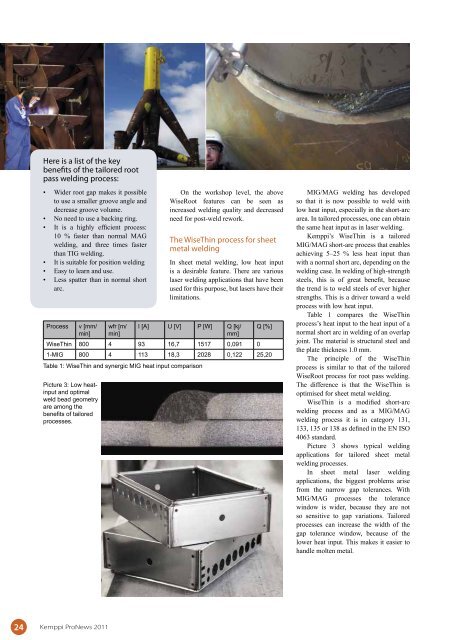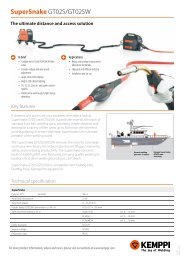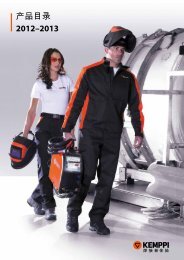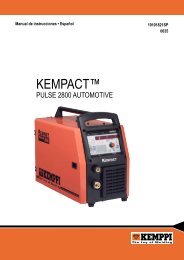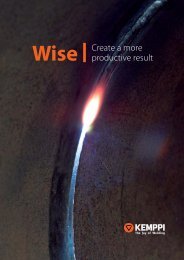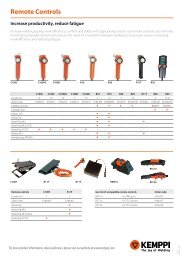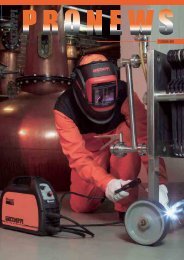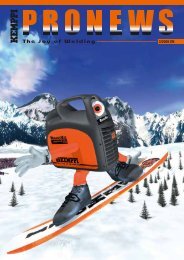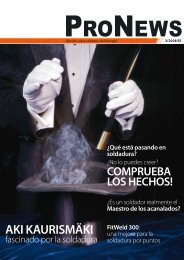Download - Kemppi Connections
Download - Kemppi Connections
Download - Kemppi Connections
Create successful ePaper yourself
Turn your PDF publications into a flip-book with our unique Google optimized e-Paper software.
Here is a list of the key<br />
benefits of the tailored root<br />
pass welding process:<br />
• Wider root gap makes it possible<br />
to use a smaller groove angle and<br />
decrease groove volume.<br />
• No need to use a backing ring.<br />
• It is a highly efficient process:<br />
10 % faster than normal MAG<br />
welding, and three times faster<br />
than TIG welding.<br />
• It is suitable for position welding<br />
• Easy to learn and use.<br />
• Less spatter than in normal short<br />
arc.<br />
Process<br />
v [mm/<br />
min]<br />
wfr [m/<br />
min]<br />
I [A] U [V] P [W] Q [kj/<br />
mm]<br />
Q [%]<br />
WiseThin 800 4 93 16,7 1517 0,091 0<br />
1-MIG 800 4 113 18,3 2028 0,122 25,20<br />
Table 1: WiseThin and synergic MIG heat input comparison<br />
Picture 3: Low heatinput<br />
and optimal<br />
weld bead geometry<br />
are among the<br />
benefits of tailored<br />
processes.<br />
On the workshop level, the above<br />
WiseRoot features can be seen as<br />
increased welding quality and decreased<br />
need for post-weld rework.<br />
The WiseThin process for sheet<br />
metal welding<br />
In sheet metal welding, low heat input<br />
is a desirable feature. There are various<br />
laser welding applications that have been<br />
used for this purpose, but lasers have their<br />
limitations.<br />
MIG/MAG welding has developed<br />
so that it is now possible to weld with<br />
low heat input, especially in the short-arc<br />
area. In tailored processes, one can obtain<br />
the same heat input as in laser welding.<br />
<strong>Kemppi</strong>’s WiseThin is a tailored<br />
MIG/MAG short-arc process that enables<br />
achieving 5–25 % less heat input than<br />
with a normal short arc, depending on the<br />
welding case. In welding of high-strength<br />
steels, this is of great benefit, because<br />
the trend is to weld steels of ever higher<br />
strengths. This is a driver toward a weld<br />
process with low heat input.<br />
Table 1 compares the WiseThin<br />
process’s heat input to the heat input of a<br />
normal short arc in welding of an overlap<br />
joint. The material is structural steel and<br />
the plate thickness 1.0 mm.<br />
The principle of the WiseThin<br />
process is similar to that of the tailored<br />
WiseRoot process for root pass welding.<br />
The difference is that the WiseThin is<br />
optimised for sheet metal welding.<br />
WiseThin is a modified short-arc<br />
welding process and as a MIG/MAG<br />
welding process it is in category 131,<br />
133, 135 or 138 as defined in the EN ISO<br />
4063 standard.<br />
Picture 3 shows typical welding<br />
applications for tailored sheet metal<br />
welding processes.<br />
In sheet metal laser welding<br />
applications, the biggest problems arise<br />
from the narrow gap tolerances. With<br />
MIG/MAG processes the tolerance<br />
window is wider, because they are not<br />
so sensitive to gap variations. Tailored<br />
processes can increase the width of the<br />
gap tolerance window, because of the<br />
lower heat input. This makes it easier to<br />
handle molten metal.<br />
24 <strong>Kemppi</strong> ProNews 2011


